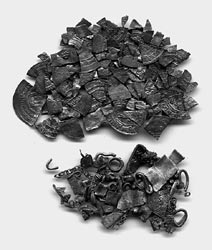
On
Friday 13th May 2005 a hoard was discovered in Dębicz, district
of Środa Wielkopolska, where it had been buried in a then unpopulated
area about the middle of the tenth century. As a result of archaeological
investigations more than 200 silver artefacts were recovered from
the soil - fragments of Islamic coins and silver ornaments, many
of which were decorated with filigree and granulation. Also recovered
were fragments of the pot in which the hoard had been hidden.
This hoard was first discovered by accident in 1936, during felling
of the forest. The artefacts recovered then were lost. The first
discovery of the investigation team was the finding after nearly
70 years of the only one of the six original finders who was still
alive, Józef Wojtczak, presently living in Słupsk. Without the
more detailed information from him, the rediscovery of the hoard
would not have been possible. The recent investigations allow
an almost full reconstruction of the context and chronology of
the find, for this time the discovery of the findspot was not
an accidental occurrence, but the effect of the execution of a
planned investigation, financed by the Ministry of Science and
Information Technology, having the aim of the verification of
former discoveries of Early Medieval hoards from the Great Poland
region. The discovery was made by the archaeologist Mirosław Andrałojć
and the electronics engineer Piotr Szyngiera, further fieldwork
was directed by Małgorzata Andrałojć, and conducted by archaeologists
Patrycja Silska and Marcin Szydłowski and archaeology students
- Tomasz Bartoszewski, Kamil Maciejewski and Marcin Maciejewski.
The grant is administered by the Archaeology Museum in Poznan,
and its director is Dr. Andrzej Prinke.

